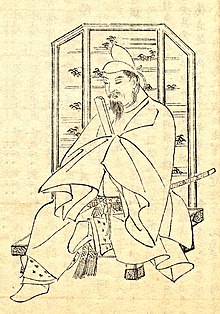Sugawara no Michizane


Sugawara no Michizane ( Japanese 菅原 道 真 ; * 845 ; † March 26, 903 ) was a scholar , poet and politician of the Heian period in Japan . He is regarded as an excellent poet, especially of Chinese poetry , and is venerated as a Kami of learning under the name Tenjin in many Shinto shrines .
biography
He was born into a family of scribes. His family had served the court since his grandfather and taught history at the National School for future officials . His father started a private school in his house and taught students who were preparing for the entrance exam to this school or who had ambitions to become officials of the court.
Sugawara passed the exam and entered Daigaku , as the national academy was called at the time. After graduation he began his career as a scholar at court. He was also appointed to a position as a government official. Sometimes he was called in for diplomatic services because of his Chinese language skills, for example as the host of foreign embassies. In addition to his services at court, he continued to run the school his father had founded. He was also appointed Monjo Hakushi , the highest teaching post on Daigaku. At that time, this office was considered the highest honor that a historian could achieve.
Sugawara later lost the favor of the court and was appointed governor of a province. He had also been appointed to such offices before, but only nominally. He lost his job as a professor and had in the province move whose governor he was now. However, when a political conflict broke out between Emperor Uda and Fujiwara no Mototsune , he sent his statement to Mototsune and won his favor. Although his tenure as governor was not over, he was recalled to Kyoto .
Sugawara rose high at the imperial court under the favor of the emperor Uda. In 894 he decided to abolish the imperial embassies in China, which he no longer considered useful because of the decline of the Tang Dynasty . But in 901 he fell victim to an intrigue of his rival Fujiwara no Tokihira and was demoted to a lower official in the city of Dazaifu in the province of Chikuzen on Kyushu .
Posthumous legend formation
After his lonely death, epidemics and drought broke out and the sons of Emperor Daigo died one after another. The Great Audience Hall of the Imperial Palace ( Shishinden ) was repeatedly struck by lightning, and the city suffered weeks of rainstorms and floods. These disasters were attributed to the angry spirit ( Onryō ) of the exiled Sugawara in the form of the thunder god Raijin and the imperial court built a Shintō shrine with the name Kitano Tenman-gū in Kyōto and dedicated it to Sugawara no Michizane, who returned posthumously in Kyōto his offices and titles was established. Mentions of his exile have been removed from the records.
literature
- Ichiro Hori (Author), Joseph M. Kitagawa, Alan L. Miller (Eds.): Folk Religion in Japan: Continuity and Change (= Haskell Lectures on History of Religions , Vol. 1). University of Chicago Press, Chicago / London 1994, ISBN 0-226-35334-6 , pp. 43-51.
- Stanca Scholz-Cionca: Aspects of medieval syncretism in the image of Tenman Tenjin in the Nô (= Munich East Asian Studies , vol. 59). Steiner, Stuttgart 1991, ISBN 3-515-05623-8 , pp. 7-9 & 18-20.
- Ivan Morris: Samurai or From the Dignity of Failure: Tragic Heroes in the History of Japan , Insel Verlag, Frankfurt am Main and Leipzig 1999, pp. 60–89
| personal data | |
|---|---|
| SURNAME | Sugawara no Michizane |
| ALTERNATIVE NAMES | 菅原 道 真 (Japanese) |
| BRIEF DESCRIPTION | Japanese scholar , poet and politician |
| DATE OF BIRTH | 845 |
| DATE OF DEATH | March 26, 903 |